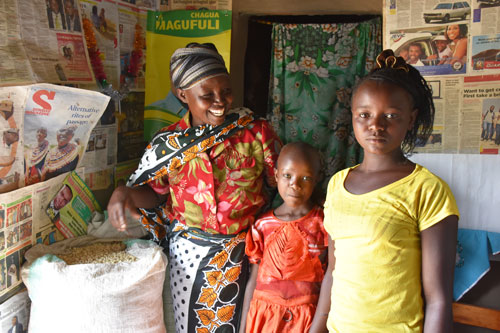
About her last maize harvest in August 2015, Valeria Pantaleo, a 47-year-old wife and mother of four from Olkalili village, northern Tanzania, waxes lyrical: “I finally managed to buy a calf to replace my two oxen that died at the beginning of the year due to a strange disease.” Valeria relies on the oxen to plow her two-acre land.
Valeria beams as she looks at her newly acquired calf. From her joy, one would be forgiven for assuming that the village enjoyed a good season. More so since Valeria had a handsome harvest that gave her a surplus four 50-kilogram bags of maize which she sold to buy the calf.
But nothing could be further from the truth. Farmers from her village suffered from exceptionally low rains during the main planting season in January–February 2015. To make matters worse, the rains were very late and poorly distributed. And as Olkalili is semi-arid, scanty rains are the biggest challenge for farming. “The rains came in late February, fell for just one day and only came back towards end of March for a few days,” laments Valeria.
For this reason, many farmers did not anticipate any substantial harvest even from an improved new maize variety – HB513 – introduced to them by Anthony Mwega, a community leader. The variety is locally known as ngamia, Kiswahili for ‘camel’, a testimonial moniker coined by ngamia suppliers, Meru Agro Tours and Consultant Limited, to symbolize the variety’s proven resilience during drought, compared to other varieties.
A boon in drought
“We heard about this new seed from Mwega who also sells hybrid seeds. But since it was my first time to use it, and given that the rains were really low, I did not expect much,” explains Valeria. “This of course was a big worry for me and my family,” she adds.
However, despite the patchy rains, Valeria managed to harvest 10 bags of 50 kilograms each from the one acre on which she planted 10 kilograms of HB513 seed – half of her farm. “I got so much harvest and yet I planted this seed very late, and with no fertilizer,” exclaims Valeria. What is special about HB513 seed is that it is both drought-tolerant and nitrogen-use efficient (see Kenya equivalent). So, compared to other varieties, it not only yields more during moderate drought, but also utilizes what little nitrogen there is in the soil more efficiently. HB513 is one of the 16 hybrid varieties developed for Tanzania by the Drought Tolerant Maize for Africa Project. Besides giving farmers the benefit of nearly 49 percent more grain during moderate drought, this hybrid seed offers them an opportunity to make best use of what little fertilizer they can afford to apply.
More enriching than just meat, and reaching more
For Valeria, it means that her family has enough maize to last them until February 2016. And a ‘meaty’ more: at sowing and growing time, since Valeria did not anticipate such a good harvest given the devastation drought portends, she resolved to work extra-hard in her small grocery business to raise enough money for the calf. “Even then, it would have taken me at least nine months to raise enough money for the calf,” she recalls. “But thanks to my unexpected bonus maize harvest, I got the calf within five months! This was such a huge relief and a blessing to me. Now I will have the much-needed help to plow my land in the next planting season.”
Through partnership with the Improved Maize for Africa Project, in 2015 alone, Meru Agro produced and sold 427 tons of ngamia seed. The result? Approximately 65,000 smallholder farmers across major maize-growing areas in northern, southern highland, central and northwest regions of Tanzania including Valeria’s village have benefited from this variety. And the good news is that the plan is to reach even more farmers in the coming years with the ‘gospel’ of ngamia.
What is the bigger picture for Tanzanian maize farmers? Meru Agro has committed to increase production of ngamia seed in 2016. “We foresee a much higher demand for ngamia because farmers are now more aware of this seed. Our plan is to produce more than 1,000 tons,” says Chacha Watanga, Meru Agro Managing Director.
Meru Agro will not be working alone. CIMMYT, through its Drought Tolerant Maize for Africa Seed Scaling (DTMASS) Project, will continue to partner with Meru Agro and other small- and medium-scale seed companies to increase production of improved maize varieties such as ngamia to reach 2.5 million people in seven target countries across eastern and southern Africa (Ethiopia, Kenya, Malawi, Mozambique, Tanzania, Uganda and Zambia). “Within its three-year lifespan, DTMASS will support production of about 12,000 metric tons of certified seed to reach smallholders who need this seed to overcome the big challenge of drought,” adds Tsedeke Abate, DTMASS Project Leader. Watch this space!
Further reading:
Scorecard as a marathon maize project winds up after eight years
Improved Maize for African Soils
Drought Tolerant Maize for Africa
About Drought Tolerant Maize for Africa Seed Scaling
 Capacity development
Capacity development